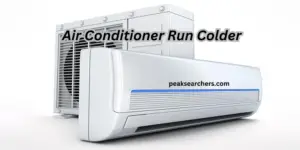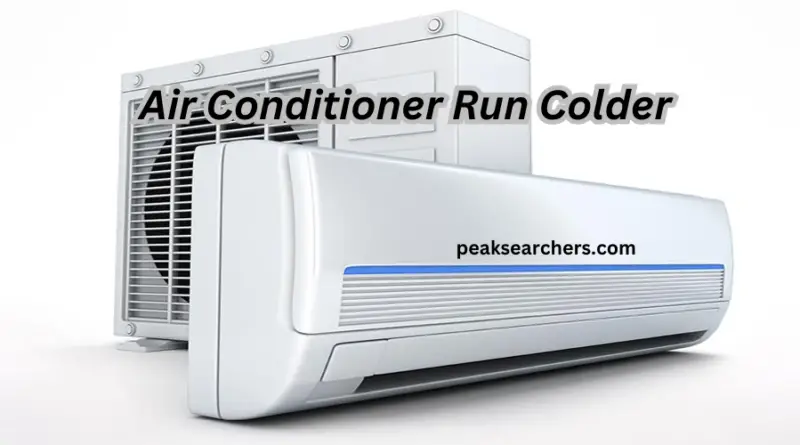How To Make An Air Conditioner Run Colder – A Comprehensive Guide
When it comes to beating the summer heat, air conditioners are a savior. But what if your AC is not running as cool as you want it to? There could be several reasons why an air conditioner is not functioning optimally, and most of them have simple solutions. In this blog post, we will explore some tips and tricks that can help you make your air conditioner run colder.
I also wanted to make my AC colder when it became older. The cooling was decreasing with time. I did not know how to get more cooling. But, then a professional guided me and I was amazed to know how simple it was to make the AC run colder!

Reasons to Make AC Colder
One of the primary reasons to make your air conditioner colder is for more efficient cooling. When you set your AC to a lower temperature, it will work harder and faster to cool down the room. This means that if you want to quickly cool down a hot and stuffy space, setting your AC at a colder temperature is essential.
Another reason to make your AC colder is for better sleep quality. Research has shown that sleeping in cooler temperatures can result in better restorative sleep and reduce the risk of insomnia. So, if you have trouble sleeping in warmer temperatures, turning up the coldness on your AC may be helpful.
Lastly, reducing humidity levels in the home is another benefit of making an air conditioner run colder. When humidity levels are high, it can cause discomfort and health issues such as allergies or asthma.
By lowering humidity levels through effective cooling with an AC unit set at a lower temperature, you can create a more comfortable living environment while also improving indoor air quality.
Step 1: Increase Coolant Refill
The first step in making your air conditioner run colder is to increase the coolant refill. The coolant in an AC system is a vital component that helps regulate the temperature of your home or office space.
Over time, the coolant level may decrease due to natural wear and tear or leaks in the system. If you notice that your AC unit is not performing as well as it used to, it may be time for a coolant refill.
To increase the coolant refill, you will need to contact a certified HVAC technician who specializes in AC repair and maintenance. They will assess your system’s current state and determine if more refrigerant needs to be added. It is essential to hire a professional as they have the specialized knowledge and equipment necessary for this task.
Once the technician has completed refilling your AC unit’s refrigerant levels, you can expect to see a significant improvement in its performance. Your air conditioner should cool down faster and maintain optimal temperatures throughout your home or office space without any issues.
Remember always to follow manufacturer guidelines regarding regular maintenance checks on your air conditioning unit, including refilling coolants when necessary, ensuring maximum efficiency.
Step 2: Check Air Filters
Air filters play a crucial role in the performance of an air conditioner. Dirty and clogged filters can cause a decrease in airflow, which leads to poor cooling efficiency.
Therefore, it is essential to check and replace air filters regularly. In fact, experts recommend changing the filter every three months or even more frequently if you have pets or allergies.
When checking the air filter, make sure it is clean and free of debris. If you notice any dust or dirt buildup, it’s time to replace the filter with a new one. Before installing a new filter, ensure that you choose the correct size and type for your AC unit. Different models require different types of filters depending on their capacity and features.
Step 3: Control Temperature Settings
The temperature setting of an air conditioner plays a crucial role in determining how cold the room will be. To make your AC run colder, you need to ensure that the temperature settings are correct. The first step is to check if your AC’s thermostat is working correctly. If it isn’t, then you may need to get it repaired or replaced.
Next, ensure that the temperature settings on your AC unit are appropriate for your needs. If you want cooler air, set the thermostat lower than usual and wait for a few minutes until the room cools down. However, be careful not to set it too low as this can cause damage to your AC unit and even increase energy costs.
Finally, consider upgrading to a programmable thermostat that allows you to adjust the temperature settings according to specific times of day or night.
This feature can help save energy and money while ensuring that your home stays comfortable at all times. By controlling temperature settings effectively, you can keep your home cool during the hot summer months without breaking the bank!
Step 4: Clean Evaporator Coil
Cleaning the evaporator coil in your air conditioning unit is essential to ensure that it runs cooler. Over time, dust and debris can accumulate on the surface of the coil, making it less effective at cooling air.
To clean your evaporator coil, first, turn off the power to your AC unit. Then remove the access panel on the front of the air handler to expose the evaporator coil.
Next, use a soft brush or cloth to gently remove any dirt or debris from the surface of the coil. Be careful not to damage or bend any of the delicate fins that make up its structure. If there is stubborn dirt or grime on your evaporator coil, you may need to use a commercial cleaning solution designed specifically for this purpose.
Finally, when you have finished cleaning your evaporator coil, replace any panels you removed and turn the power back on to your AC unit. With regular cleaning and maintenance like this, you can help prolong the life of your air conditioning system and keep it running efficiently for years to come.
Step 5: Inspect Condenser Unit
To ensure that your air conditioner runs efficiently and produces the coldest air possible, it’s important to inspect the condenser unit regularly.
The condenser unit is responsible for releasing heat from inside your home to the outside environment. If it becomes dirty or clogged with debris, it can’t release heat effectively, causing your AC unit to work harder than necessary.
Start by turning off the power supply to the AC unit and removing any debris, such as leaves or twigs, from around the condenser unit. Next, remove the fan guard and clean any dirt or debris from around the fan blades using a soft brush or cloth. It’s important not to use water when cleaning this area as it may damage electrical components.
FAQ’s
Q: How often should I change my air conditioner’s filter?
A: The frequency of changing your air conditioner’s filter depends on several factors such as the type of filter you’re using, the number of people and pets in your home, and how frequently you use your AC.
Typically, it is recommended to change a standard 1-2 inch pleated filter every three months. However, if you have pets or allergies, it is best to replace them every 6-8 weeks.
Q: Can I place furniture in front of my air conditioner?
A: It’s not advisable to put furniture directly in front of an air conditioning unit as it can obstruct airflow and reduce its efficiency. To ensure optimal cooling performance, make sure there are no obstructions around the unit that may block the airflow. If possible, try to keep at least two feet of space between any objects and your AC system.
Q: What temperature should I set my thermostat for optimal cooling?
A: For optimal cooling during hot weather conditions, it is recommended to set your thermostat at 78°F (25°C) during the day when you are home and increase it by a couple of degrees when no one is home.
This will help you save energy while still keeping your space comfortable. Additionally, using ceiling fans or other circulating fans can help improve indoor comfort levels without relying too much on your air conditioning system.
Also read: Fix A Split AC Compressor That Won’t Turn On
Conclusion:
In conclusion, there are several ways to make an air conditioner run colder. The first step is to change or clean the filter regularly as a dirty filter can affect the AC’s performance. Secondly, ensure that the unit is properly sized for the room it’s cooling and keep all doors and windows shut to prevent warm air from entering.
Thirdly, consider installing a programmable thermostat that can help regulate temperature settings according to your schedule. Another option is to use ceiling fans in conjunction with your AC which helps circulate cool air throughout the room.
Finally, if none of these options work, you may want to consider upgrading your current AC unit. Newer models are more energy-efficient and have advanced features such as multiple-speed fans and smart thermostats that can help improve performance and save on energy costs in the long run.


